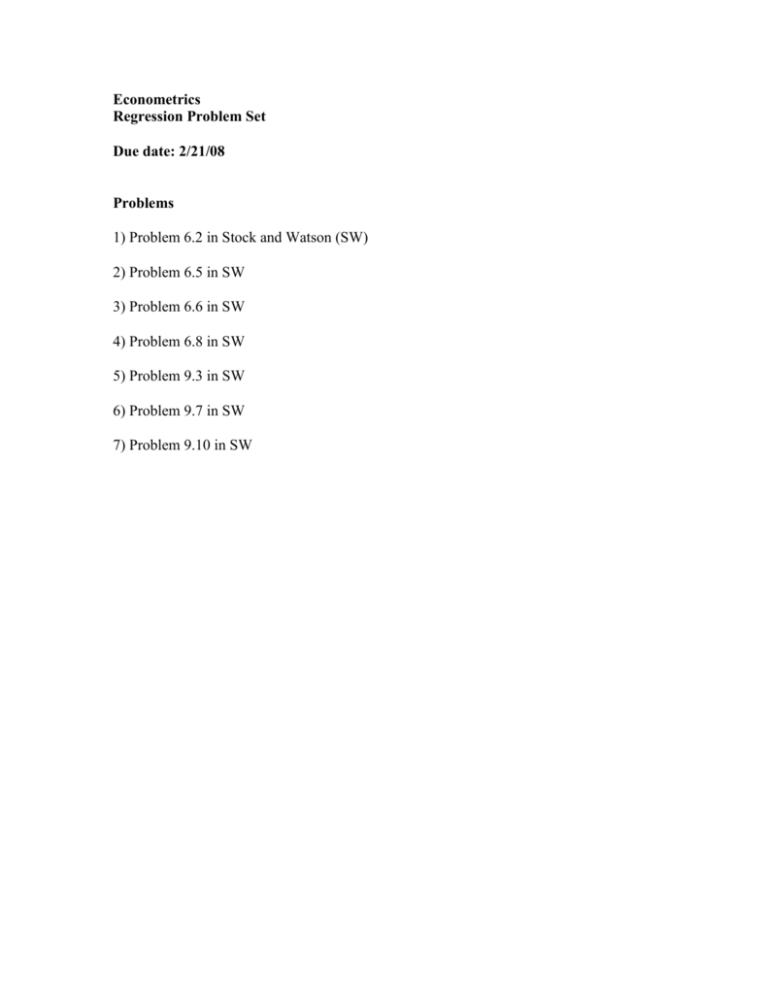Econometrics
advertisement

Econometrics Regression Problem Set Due date: 2/21/08 Problems 1) Problem 6.2 in Stock and Watson (SW) 2) Problem 6.5 in SW 3) Problem 6.6 in SW 4) Problem 6.8 in SW 5) Problem 9.3 in SW 6) Problem 9.7 in SW 7) Problem 9.10 in SW Solutions 1. (a) Workers with college degrees earn $5.46/hour more, on average, than workers with only high school degrees. (b) Men earn $2.64/hour more, on average, than women. 2. (a) $23,400 (recall that Price is measured in $1000s). (b) In this case BDR 1 and Hsize 100. The resulting expected change in price is 23.4 0.156 100 39.0 thousand dollars or $39,000. (c) The loss is $48,800. (d) From the text R2 1 nnk11 (1 R2 ), so R2 1 nnk11 (1 R2 ), thus, R2 0.727. 3. (a) There are other important determinants of a country’s crime rate, including demographic characteristics of the population. (b) Suppose that the crime rate is positively affected by the fraction of young males in the population, and that counties with high crime rates tend to hire more police. In this case, the size of the police force is likely to be positively correlated with the fraction of young males in the population leading to a positive value for the omitted variable bias so that the coefficient for the effect of police on crime is higher than the true effect. In other words, perhaps the true effect of adding an additional police office is a decrease in the crime rate of .01%, but this source of bias causes us to estimate that an additional police officer only causes a .005% drop in crime. For this reason, it is likely that omitted variable bias will cause us to underestimate the true effect that police force size has in reducing crime. 4. Omitted from the analysis are reasons why the survey respondents slept more or less than average. People with certain chronic illnesses might sleep more than 8 hours per night. People with other illnesses might sleep less than 5 hours. This study says nothing about the causal effect of sleep on mortality. 5. The fact that the sample only includes employed women is the key point. It is likely (and in fact, the case), that averages wages for all women are smaller when the number of kids is higher. However, a large part of this is accounted for by the fact that many women who have many children are not working at all. Think of this extreme case. Suppose that almost every woman with 8 kids or more does not have paying work, but that the few women who do work earn a great deal of money. Even though the true relationship between kids and earnings is negative, if we look just at employed women, we will make the mistake of finding a positive relationship, because the sample of employed women only includes the extraordinary cases where the women are capable of having 8 kids and working at the same time. 6. A) True. For all the reasons we discussed in class, we will get a biased estimate if X is correlated with the error term. B) True. Each of the conditions listed on p. 357 will lead to correlation with the error term. 7. These estimates are not internally valid – not a valid estimate of the effect of education of earnings for all workers aged 30 to 64 – because they fail to account for the ability problem. This means education is correlated with the error term. It does so happen that the effect turns out to not be far off, as other research has shown. It is not externally valid either – it is not a valid estimate of the effect of education on earnings for all people of all ages.





















